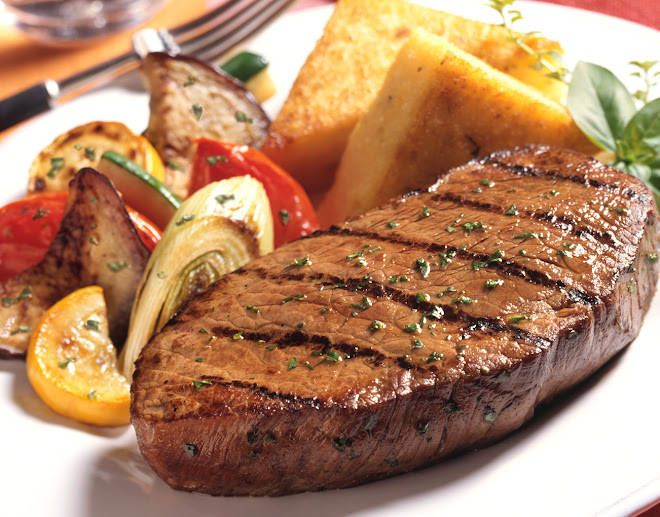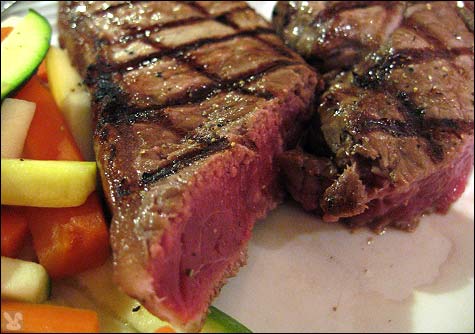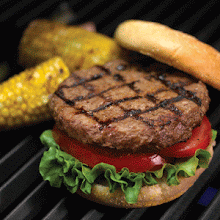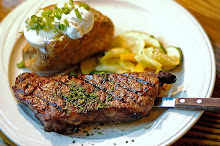
With the December holidays upon us, it is a time of year for celebrations with family, friends and office colleagues. Depending on your comfort level with managing a gluten-free diet, it may be a season you welcome with open arms, or one you approach with concern. Regardless of where you are on your personal gluten-free journey, American Steak & Seafood restaurants can be one of the safer choices for an optimal dining experience.
These restaurants are great representations of the bountiful harvests of American farmers, fishermen and ranchers. Produce, meat and seafood are typically prepared in a culinary fashion that produces wholesome and satisfying eating out experiences. The range and style of Steak & Seafood houses in America is diverse. Whether you are dining at a single independent restaurant or a large restaurant chain, each establishment has a unique atmosphere and feeling. There is the classic New York style steakhouse with its career waiters in white coats and bistro aprons, or the casual wait staff at family-oriented theme restaurants. Some restaurants choose the fusion approach of blending other international cuisines with standard steak and seafood dishes, while others give you the feeling of eating at an authentic western saloon.
American Steak & Seafood restaurants will carry a variety of beef cuts and follow the scale of quality set forth by the U.S. government. Beef is graded for quality by U.S. Department of Agriculture (USDA) graders according to standards established by the USDA. Grades are based on the amount of marbling (flecks of fat within the cut of meat) and the age of the animal. These quality grades are an indication of palatability characteristics such as tenderness, juiciness, and flavor. While there are eight quality grades for beef, the top three grades available to most consumers are prime, choice and select.
In addition to beef, you may find lamb, pork and chicken on the menu. Many types of seafood are also typically available including Maine lobster, Alaskan king crab, oysters, mussels, salmon and shrimp. Again, the preparation of these dishes is minimal and in most cases involves baking, boiling, grilling, pan frying or steaming.
Starch dishes available are usually potato-based, such as baked potatoes, French fried potatoes, mashed potatoes, roasted potatoes and hash browns. Rice dishes and pastas are also available. Vegetables play a big part in this type of cuisine. Both in salads and in side dishes, you may see asparagus, artichokes, broccoli, carrots, green beans, hearts of palm, different types of lettuce, olives, onions, potatoes and tomatoes. Herbs include basil, garlic, rosemary, and thyme.
Since Steak & Seafood restaurants are ubiquitous throughout the US, you will have few issues finding suitable venues near your home or while traveling for the holidays. If you live in or are visiting Pennsylvania, New York or New Jersey, one restaurant chain is continuing to build a significant reputation within the gluten-free community. Charlie Brown’s Steakhouse restaurants are becoming known for their gluten-free menus, their commitment to providing quality service to each gluten-free guest, and most recently complimentary gluten-free desserts with a coupon as described below in the Restaurant Spotlight!
For those wanting to explore Steak & Seafood restaurants in other parts of the country, outlined below are sample questions to ask restaurant personnel without gluten-free menus when ordering hamburgers, French fries and flourless chocolate torte! To ensure that your meal is gluten-free when a restaurant does not have a gluten-free menu, you need to be prepared to ask specific questions to the server, manager or chef, depending upon your level of comfort and preferences.
As an example, when ordering a hamburger as your meat entree, you need to ask:
•Do you make the hamburgers with bread crumbs?
•Do you prepare your burgers with any seasonings? If so, what types of seasonings are used?
•If packaged seasonings are used, does the ingredient list include wheat, rye, barley or gluten?
•Since I can't eat any gluten, wheat or bread, can I have my burger without a bun?
For French Fries, you need to ask the following questions:
•Are your fries fried in the same fryer as your onion rings or breaded chicken fingers?
•Are your fries flour dusted?
•Are your fries seasoned? If so, what types of seasonings are used?
•If packaged seasonings are used, does the ingredient list include wheat, rye, barley or gluten?
For a flourless chocolate torte dessert, although the name implies differently, you still need to ask:
•Is any wheat flour included as an ingredient?
•Are any bread crumbs added to this torte?
•Is wheat flour used to dust the pan prior to baking?
Also, remember that if the answer from the server, manager or chef, to any of these questions is yes, (besides the “no bun” request), then you will need to choose a different entrée, side dish or dessert. Be sure to continue to ask the right questions to ensure safe gluten-free dining experiences. Great gluten-free meals await you and the American Steak & Seafood experience continues to be a classic cuisine option. With so many menu possibilities available, you can be sure to find something delicious for everyone in your dinner party. Eat, Drink and be Merry! Happy Holidays!
Restaurant Spotlight
Charlie Brown’s Steakhouse
For gluten-free guests, all Charlie Brown’s Steakhouse restaurants offer a gluten-free menu. No matter which of the 54 locations you choose to visit, a substantial number of gluten-free options are available everyday. Each restaurant offers prime rib, delicious steaks, unlimited Farmer’s Market Salad Bar and much more. Their philosophy is simple — to provide great food, exceptional value and friendly service to each and every customer they serve. Charlie Brown's is known for its high quality, fresh food and good value, serving USDA Choice or better mid-western beef including Certified Angus Beef.
Charlie Brown’s Steakhouse roots can be traced to 1966, when The Jolly Trolley opened in Westfield, NJ. Over the past 40 years, they have grown to over 50 locations and have expanded into New York and Pennsylvania with more restaurants planned for the future. Reflecting their neighborhood locations, each restaurant is unique, and restaurant size and seating varies widely. All locations feature comfortable dining rooms; casual, friendly bars and lounge areas; and the Farmer’s Market Salad Bar. Many locations also offer private banquet rooms.
Now through March 31, 2008, Charlie Brown’s Steakhouse is offering complimentary desserts to the gluten-free community exclusively through Glutenfreeonthego.com, as another demonstration of their significant support to the gluten-free and special diets community. Guests must purchase a gluten-free entrée and present the coupon to their server to receive their complimentary gluten-free dessert.
Coupons are available from each of the 54 Charlie Brown’s Steakhouse Qualified Listings featured on Glutenfreeonthego.com, the world’s largest on-line directory of gluten-free restaurants. Simply visit Glutenfreeonthego.com to download and print your coupon, and then present it to your server at any location. There is a limit of four (4) complimentary desserts per table, per visit; however, there is no limit to how often you dine!
Also, in an effort to ensure the highest levels of satisfaction, Charlie Brown’s Steakhouse would like feedback on your gluten-free dining experiences to help further understand your future needs and expectations. After your meal, be sure to return to any Charlie Brown’s Qualified Listing on Glutenfreeonthego.com and participate in the brief customer satisfaction survey. So, stop in today for a tasty gluten-free dining experience. No matter where you are, you can expect the same friendly service, great value and delicious gluten-free food each and every day of the week!
thank you glutenfreeda.com






